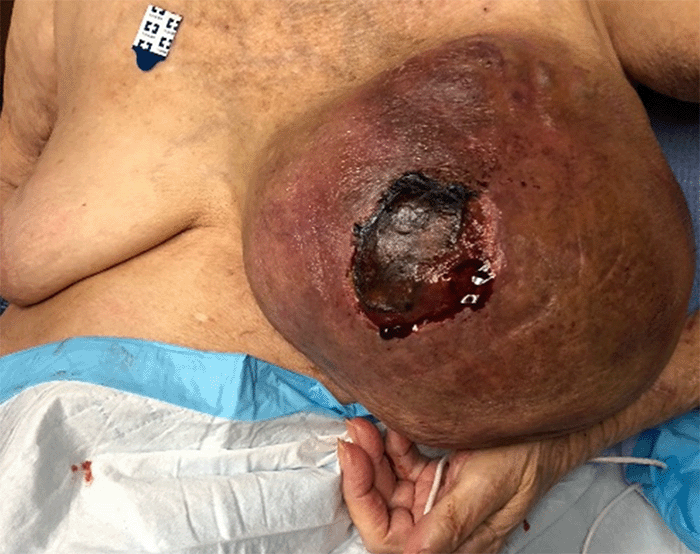Discussion
Papillary carcinoma is a distinct family of breast cancer. The group is defined by the presence of an aberrant fibrovascular core surrounded by epithelium. Care must be taken to distinguish these lesions from benign papillomas, which is completed through pathologic examination of the myoepithelial layer, which remains intact in benign papillary lesions. Papillary cancers are typically intraductal; however, they can extend beyond this architecture and be deemed invasive. Classification of IPCB is seen in less than 1% of breast cancers; this diagnosis requires the presence of an infiltrating lesion with a structure consisting of >90% papillary morphology. Necrosis may be present, however, in small regions and are often concordant with biopsy sites.4,6 With the rarity of this entity, it is not surprising that confusion may occur when dealing with other similarly named breast lesions. One example is invasive micropapillary carcinoma, which lacks a true fibrovascular core and consists of malignant cells in a nest or tube-like arrangement with surrounding clear spaces. Differentiating these lesions is crucial, as invasive micropapillary carcinoma is more aggressive, can be affiliated with metastasis to axillary nodes, and exhibit lymphovascular invasion.4,6
Invasive papillary carcinoma is more common in postmenopausal females in the sixth to eighth decade of life. Clinical presentation can involve a painless, slow-growing breast mass localized to the central portion of the breast and may be accompanied by hemorrhagic nipple discharge.5,7 Radiologic findings for papillary carcinomas may vary; however, they may appear as an intracystic mass, intraductal mass, or as a solid pattern with an intraductal mass completely filling the duct. Intraductal masses may also induce ductal dilation visible on ultrasound. Calcifications may be seen in either benign or malignant papillary lesions. However, microcalcifications were associated more commonly with malignant lesions. Unfortunately, both benign and malignant papillary lesions tend to be viewed as well-circumscribed ovoid or rounded masses.4,6
In terms of treatment, modalities may be variable due to the scarcity of IPCB. In many cases, clinical strategies for IPCB resemble those for the more common forms of breast cancer, including the use of mastectomy with axillary dissection and options for chemotherapy and radiation treatment. Unfortunately, specific treatment guidelines and data on the effectiveness of treatment modalities (including chemotherapy) are lacking due to the rarity of this form of breast cancer.2‒4 There is still ongoing debate on whether papillary lesions identified through core needle biopsy should be excised or simply monitored with conservative surveillance.4
In this patient's case, while age and postmenopausal status were typical for invasive papillary carcinoma, her presentation deviated from classical findings. Features that varied included the size of the mass, the degree of specimen necrosis involved, the presence of acute hemorrhage requiring a damage control procedure, and evidence of metastatic disease. All features indicated a higher grade lesion with a poorer prognosis than other cases of IPCB.
This patient's presentation highlighted the lack of IPCB treatment protocol. In this case, evidence of acute hemorrhage caused an oncologic procedure to be swapped for damage control due to the necessity for patient safety and the extent of the mass. As a result, preoperative workup was aborted, and surgical resection was indicated in this emergent circumstance.
Conclusion
Papillary carcinoma of the breast is defined by the presence of epithelial proliferation surrounding fibrovascular cores. Pending the degree of proliferation and depth of invasion, these lesions may be classified as invasive or in situ.1,4,6 Invasive papillary carcinoma of the breast ( is an exceptionally rare form of breast cancer, comprising less than 1% of cases. IPCB tends to impact postmenopausal women in the sixth to eighth decade of life.1,4,6 While presentation may involve a painless, slow-growing breast mass, or hemorrhagic nipple discharge, it may also present as an asymptomatic lesion on radiographic exams.5,7
Due to the rarity of papillary carcinomas, especially the subclass of invasive papillary carcinoma, specific treatment guidelines are lacking. In cases requiring emergent intervention, such as those involving acute hemorrhage, aborting preoperative workup to allow for prompt surgical intervention is indicated.1‒5,7
Lessons Learned
IPCB usually presents with small, low-grade tumors in postmenopausal women with a favorable prognosis. It can present as an advanced tumor complicated by hemorrhagic appearance in an emergent setting in rare cases.
The majority exhibit estrogen and progesterone receptor expression. As a result of these characteristics, IPBC is associated with favorable clinical outcomes. In some cases, axillary lymph-node metastases have been documented in patients.
References
- Bhosale SJ, Kshirsagar AY, Sulhyan SR, Jagtap SV, Nikam YP. Invasive papillary breast carcinoma. Case Rep Oncol. 2010;3(3):410-415. Published 2010 Nov 13. doi:10.1159/000321270
- Fakhreddine MH, Haque W, Ahmed A, et al. Prognostic factors, treatment, and outcomes in early stage, invasive papillary breast cancer: a SEER investigation of less aggressive treatment in a favorable histology. Am J Clin Oncol. 2018;41(6):532-537. doi:10.1097/COC.0000000000000335
- Misra S, Solomon NL, Moffat FL, Koniaris LG. Screening criteria for breast cancer. Adv Surg. 2010;44:87-100. doi:10.1016/j.yasu.2010.05.008
- Pal SK, Lau SK, Kruper L, et al. Papillary carcinoma of the breast: an overview. Breast Cancer Res Treat. 2010;122(3):637-645. doi:10.1007/s10549-010-0961-5
- Soo MS, Williford ME, Walsh R, Bentley RC, Kornguth PJ. Papillary carcinoma of the breast: imaging findings. AJR Am J Roentgenol. 1995;164(2):321-326. doi:10.2214/ajr.164.2.7839962
- Wei S. Papillary lesions of the breast: an update. Arch Pathol Lab Med. 2016;140(7):628-643. doi:10.5858/arpa.2015-0092-RA
- Zheng YZ, Hu X, Shao ZM. Clinicopathological characteristics and survival outcomes in invasive papillary carcinoma of the breast: a SEER population-based study. Sci Rep. 2016;6:24037. Published 2016 Apr 7. doi:10.1038/srep24037
Authors
Klosterman E; Huang K; Park I-S; Misra S
Author Affiliations
General Surgery, HCA Florida Brandon Hospital, Brandon, FL, 33511
Corresponding Author
Subhasis Misra, MD, MS, FACS
General Surgery, HCA Florida Brandon Hospital
205 S Moon Avenue
Brandon, FL 33511
Phone: (813) 662-6200
Email: subhasis.misra@hcahealthcare.com
Disclosure Statement
The authors have no conflicts of interest to disclose.
Funding/Support
The authors have no relevant financial relationships or in-kind support to disclose.
Received: July 29, 2021
Revision received: November 29, 2021
Accepted for publication: December 9, 2021





